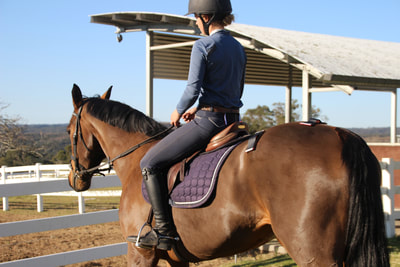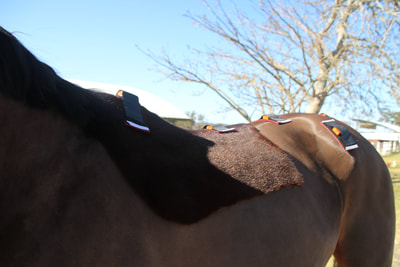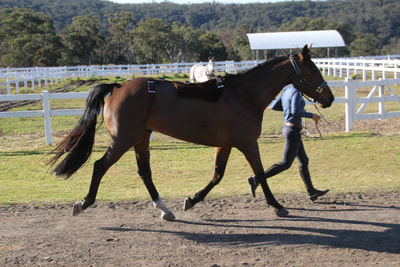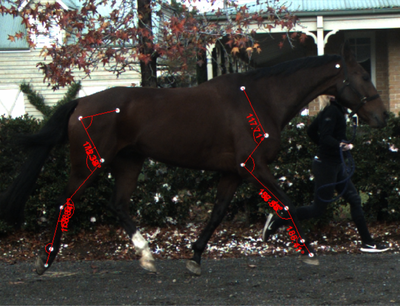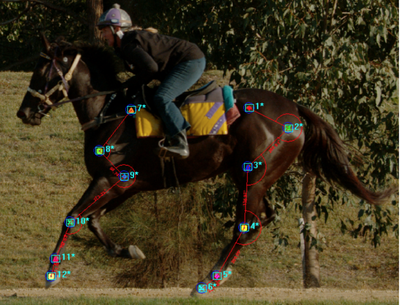Biomechanical analysis is widely used in human athletes to evaluate and optimise performance. We can now apply this innovative technology to measure how the horse moves and performs.
This technology allows us to objectively measure the horse's gait pattern, providing us with a highly specific analysis of how the horse is moving and highlight any potential issues that may be contributing to injury, behavioural concerns or limiting performance in the sport, pleasure or racehorse.
This technology allows us to objectively measure the horse's gait pattern, providing us with a highly specific analysis of how the horse is moving and highlight any potential issues that may be contributing to injury, behavioural concerns or limiting performance in the sport, pleasure or racehorse.
benefits of gait analysis
- Provide an objective baseline of horse’s normal gait pattern.
We know that no horse moves perfectly symmetrically. Obtaining a baseline measure when your horse is sound allows us to obtain an objective measurement of their normal movement pattern, so that comparisons over time can identify potential issues or improvements due to treatment / training. - Early detection of lameness and injury prevention
It can be difficult to diagnose a subtle or multi-limb lameness. We can assist your vet by detecting abnormal movement patterns away from your horse's regular baseline. Please note that we do not diagnose lamenesses or any injury in your horse, we work alongside your vet by providing them with the data. We regularly do joint consultations with veterinarians, objectively measuring how your horse responds to diagnostic tests such as flexion tests or nerve blocks. - Evaluate athletic performance
How does your horse compare to top performers? How can we improve their performance? We can compare your horse's movement patterns to that of top performers, helping us to identify what may need to be addressed in relation to improving performance . This may involve physiotherapy intervention, and/or consultation with other practitioners such as your farrier, coach, trainer, or saddle fitter. - Inform return to work after injury/rehabilitation
We can assist the veterinary, physiotherapy and farrier team with an objective measurement of symmetry and lameness and use it to evaluate recovery and effect of treatment.
Our assessments may take the form of a simple baseline analysis on its own, a joint consultation with other practitioners (such as your vet or farrier), or in conjunction with our physiotherapy consultations. Please give us a call to have a chat about how we can best utilise gait analysis to help your horse.
If you'd like to see an example of gait analysis in action, click here to read a recent case study.
If you'd like to see an example of gait analysis in action, click here to read a recent case study.
We utilise two different types of gait analysis technology.
1. inertial motion sensors
Equimotion uses an inertial sensor system that has been developed by world leading researchers at the Royal Veterinary College in London, and been shown to produce highly accurate and precise results about the symmetry of movement between left and right sides.
Like humans, horses move naturally asymmetrically. It’s important to know your horse’s baseline asymmetry to differentiate its normal movement pattern from abnormal movements.
This type of analysis allows us to assess your horse’s gait to pick up early, subtle or multi-limb lameness, monitor recovery, record a baseline of your horse’s normal gait for future comparison, or provide you reassurance of your horse’s soundness.
Many IMU systems just measure limb symmetry but the Equigait System that we use has the capacity to also measure 3-dimensional back movement. Measurements are recorded for dorsoventral, mediolateral, axial rotation, lateral bend and pitch. Along with using the back data to assist the veterinary team with diagnostics (which is especially useful in the spine due to the difficulties and cost associated with imagingg), we can use IMUs to test back movement over time during a rehabilitation program to answer questions such as:
Like humans, horses move naturally asymmetrically. It’s important to know your horse’s baseline asymmetry to differentiate its normal movement pattern from abnormal movements.
This type of analysis allows us to assess your horse’s gait to pick up early, subtle or multi-limb lameness, monitor recovery, record a baseline of your horse’s normal gait for future comparison, or provide you reassurance of your horse’s soundness.
Many IMU systems just measure limb symmetry but the Equigait System that we use has the capacity to also measure 3-dimensional back movement. Measurements are recorded for dorsoventral, mediolateral, axial rotation, lateral bend and pitch. Along with using the back data to assist the veterinary team with diagnostics (which is especially useful in the spine due to the difficulties and cost associated with imagingg), we can use IMUs to test back movement over time during a rehabilitation program to answer questions such as:
- is the rehabilitation achieving what we think it is?
- is an exercise or program of exercises having the effect that we think it is?
|
The process:
|
|
2. high-speed video analysis & 2D Kinematics
Once the domain of professional athletes and sports institutions, video analysis is now becoming more widely used across many different sports and with athletes of all abilities. Anyone looking to maximise their performance and minimise the risk of injury will benefit from kinematic video analysis.
Through the use of high-speed cameras and movement analysis software, we can obtain a detailed analysis of both the rider's and the horse's movement. Our highly specialised cameras can record up to 1000 frames per second, allowing us to detect subtle differences within the gait or movement that the human eye just can’t see. This type of detailed analysis allows for measurement of variables such as the length and frequency of the horse’s stride, joint angles and how the athlete positions and sequences each movement. This allows us to provide an objective baseline, monitor response to training or rehabilitation and provide recommendations for improved performance.
Video analysis can be used for:
The process:
Measurements include:
Reporting:
Through the use of high-speed cameras and movement analysis software, we can obtain a detailed analysis of both the rider's and the horse's movement. Our highly specialised cameras can record up to 1000 frames per second, allowing us to detect subtle differences within the gait or movement that the human eye just can’t see. This type of detailed analysis allows for measurement of variables such as the length and frequency of the horse’s stride, joint angles and how the athlete positions and sequences each movement. This allows us to provide an objective baseline, monitor response to training or rehabilitation and provide recommendations for improved performance.
Video analysis can be used for:
- Analysing posture and alignment of the rider
- Analysing the horse's movement
- Detection of movement asymmetry
- Injury prevention
- Baseline recording and monitoring
- Performance enhancement
The process:
- Reflective markers are placed on joint centres of the horse’s and/or rider's limbs
- Footage collected at walk / trot / canter or gallop
- Footage analysed through specialised software program to produce information about the horse’s and/or rider's movement patterns
Measurements include:
- Stride length, stride frequency, footfalls
- Joint angles, velocities and accelerations
- Ground contact duration
- Timing and coordination of limb action
Reporting:
- Comprehensive report
- Soundness / baseline movement blueprint
- Description of the horse’s movement patterns, including strengths and weaknesses
- Recommendations for further management/treatment
|
This video demonstrates the video analysis process. You will notice that both the horse and rider have dots placed on a number of their joints. These dots are connected to make the stick figures that are shown in the second part of the video. These stick figures allow us to objectively measure joint angles, accelerations and velocities at each phase of the jump, and provide us with detailed information on posture and movement patterns. The information this provides us to help improve both horse and rider performance is invaluable
|
|

